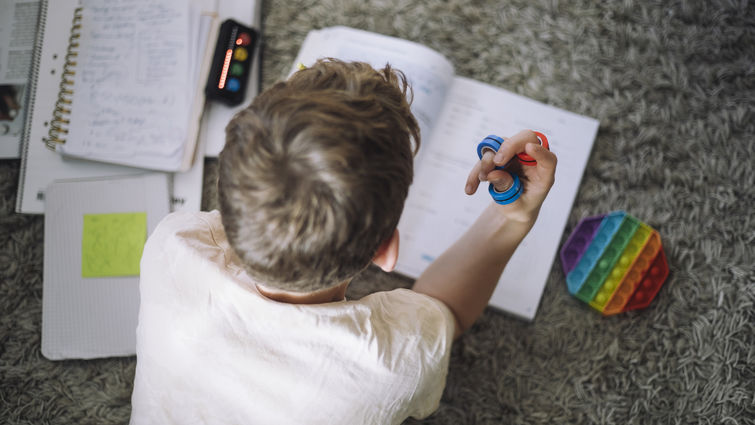

Raising a child with Attention-Deficit/Hyperactivity Disorder (ADHD) can bring plenty of fun and joy to daily life, but it can also come with its own set of challenges. ADHD is a common neurodevelopmental disorder affecting 1 in 9 children in the U.S., impacting their ability to maintain focus and manage their behavior and emotions. Children with ADHD typically have a level of physical activity and energy that extends beyond that of others their age. While all children can be forgetful, lose focus, or need reminders to do things, children diagnosed with ADHD may require more support in these areas. This can make it challenging for parents and educators to find effective ways to understand and support children with ADHD.
“ADHD has three symptom clusters: inattention, hyperactivity, and impulsivity,” says Jennifer Minami, MD, child, adolescent, and adult psychiatrist for Loma Linda University Behavioral Health. “Every person experiences symptoms that may look like ADHD, such as difficulty focusing, forgetfulness, or being impulsive from time to time. However, when these things occur to a degree that affects someone's social, academic, occupational, or home life beyond what would be expected for most others their age or educational level, we start to consider a diagnosis of ADHD.”
While some children may outgrow ADHD symptoms as they progress through adulthood, impairment from ADHD often continues for most individuals. Parents and caregivers can provide support and guidance to help children cope with their diagnosis. Below, Minami helps identify five important things your child wants you to understand about ADHD.
1. “We aren’t ‘lazy’”
Children with ADHD are often thought of as “lazy” because they struggle to keep up with tasks like homework or chores, which is not necessarily due to a lack of effort. Often, kids with ADHD understand what needs to be done, but they struggle to focus their attention, which can tend to drift toward more stimulating activities like playing video games or engaging in hobbies.
Parents need to know that when children with ADHD fail to complete their tasks, they aren’t intentionally neglecting their responsibilities or being lazy. It is a matter of how their brain prioritizes what needs to be done, which may not appear to be as fun or easy to do as their preferred activity.
“The part of the brain responsible for prioritizing tasks, regulating impulses, and focusing on what's important doesn't develop as quickly in people with ADHD,” Minami says. “This makes it much harder for them to shut off distractions and focus on things that may be less exciting and require more mental effort.”
2. “We are bright!”
Many kids diagnosed with ADHD experience academic underachievement. Over time, this can lead to poor motivation in school.
A common frustration parents express is, “How can my child focus on video games for hours but not on their homework?”
Minami points out that kids with ADHD may find it easier to focus on highly stimulating activities rather than less exciting tasks such as homework or chores. Even when a child is aware they need to complete an assignment, it can be challenging to engage in activities that require more mental effort.
3. “We get bored easily”
A typical child may get bored in a classroom but can still maintain attention when expected. A child with ADHD is more likely to zone out quickly due to difficulty focusing on unengaging tasks and being easily distracted by other thoughts or stimuli in their environment. The brains of children with ADHD respond more to new or stimulating situations than to routines. This may make everyday tasks seem less appealing, but often children with ADHD are creative and adventurous, especially with new situations.
4. Talk to their teachers
For parents of children with ADHD, it can feel overwhelming to manage their needs both at home and school. However, there are ways teachers and schools can help. Minami emphasizes the importance of collaborating with your child’s teacher, and if necessary, seeking academic accommodations through processes such as an individualized education plan or 504 plan.
Many schools can offer flexible seating options and allow students to take tests away from distracting areas. Additionally, older students can ask their teachers for help with large projects by having them broken down into smaller, weekly tasks. They can also request to take tests in a separate, quiet room to minimize distractions during exams.
5. Hyperactivity can mean a lot of talking
Hyperactivity doesn’t just manifest physically. For many kids, it shows up in the form of excessive talking. A child with ADHD may dominate conversations or talk out of turn in class, often interrupting others without realizing it.
"All humans learn to manage their emotions and behaviors, much like having a red light and a yellow light to help us slow down and think before we speak or act, and wait our turn in conversations," Minami explains. "For children with ADHD, the yellow and red light may develop later compared to their same-age peers."
For example, while someone else is talking, a child with ADHD might impulsively interrupt because they want to share immediately. Without the red or yellow light that tells them to pause or wait their turn, these impulsive actions can cause them to be labeled as inconsiderate.
It's important for parents to recognize that these behaviors, while frustrating, are often a result of ADHD rather than a child deliberately acting out. Loma Linda University Behavioral Health hosts quarterly events including helping parents understand their kids with ADHD. For more information, visit our website here, or call 909-558-9275.

